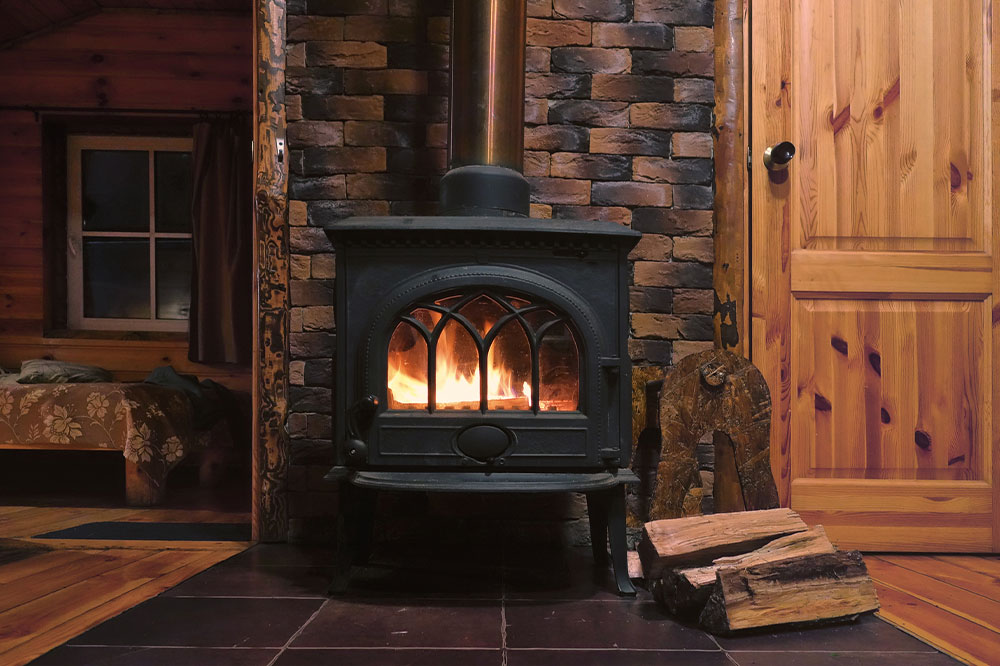
Wood stoves – Working, types, and maintenance
Wood stoves, also known as wood-burning stoves, have been in use for a very long time to keep homes warm. They are most often found in regions with harsh winters. Wood stoves are a good substitute for conventional gas or electric furnaces since they are more efficient. However, choosing one for the home can be difficult. When purchasing, a few critical aspects to consider are the stove’s material, style, size, heating capacity, and efficiency.
How do wood-burning stoves function?
To understand how wood stoves function, we must learn about their components:
- Firebox : It is the main compartment of the stove where wood is burnt to generate fire to warm the air in the room.
- Chimney : It transports the combustion gases released outside the home.
- Damper : It regulates the airflow to the stove to control the fire’s size and the amount of heat it emits.
- Baffle : A baffle prolongs the fire gasses’ combustion time. Since partially combusted gasses are significant air pollutants, this property is essential. Some stoves do not have a baffle but use other mechanisms to lower air pollution.
What are the types of wood stoves?
Wood-burning stoves are generally divided into two groups based on their construction and design:
Catalytic
In these stoves, harmful exhaust gasses pass through a honeycomb catalyst. The catalyst burns off the gasses, causing less pollution. Catalytic stoves often burn longer and suffer less heat loss than non-catalytic options. However, they require extra care because the catalysts need replacement every few years.
Non-catalytic
As the name suggests, non-catalytic stoves do not have a catalyst. Instead, they use other mechanisms to limit emissions. One example is an inside baffle that provides a longer flow channel for the harmful gasses and particles to burn.
The EPA’s emission standards for non-catalytic stoves (7.5 grams of particulate emissions per hour) are higher than those for catalytic options (4.1 g/h), reflecting the catalysts’ inevitable deterioration. When catalysts are due for replacement, emissions from catalytic models will undoubtedly have exceeded the 7.5 g/h standard.
Should you buy indoor or outdoor wood stoves?
Wood-burning stoves may also be categorized as indoor and outdoor models depending on where they must be installed:
Wood stoves for outdoors
Outdoor stoves have large doors and a rugged steel firebox with metal cladding and insulation. They usually burn big wood chunks to generate fire and release more air pollution. However, newer models have improved combustion designs to reduce environmental damage. Outdoor stoves designed to heat water can store hundreds of gallons of water. However, the water may have to be treated before use.
Wood stoves for indoors
Although heavily jacketed and insulated, indoor wood stoves cannot be placed outside. They may be found in the living rooms of houses. Indoor stoves can be installed in any place with a roof, four walls, insulation, power, and water. Compared to outdoor stoves, these hold less water. However, the water is usually clean and does not require treatment. Most indoor stoves employ a two-stage combustion process called wood gasification. They light up quickly and require maintenance every 12 to 24 hours.
How to maintain wood stoves?
It is a good idea to get a wood stove inspected when moving into a house with this facility. Licensed wood stove services can examine the stove to ensure it complies with local regulations and is safe to use. One must also conduct routine maintenance, depending on the model’s design and how frequently it is used. A general rule is to do it every year following the summer season.
Besides annual maintenance, regular cleaning is essential. Individuals can contact a wood stove service for the job or purchase the tools necessary and clean the stove themselves.
Do not have a wood-burning stove but want to invest in one? Look up the internet for options. Many online retailers have wood stoves for sale. Compare the features, read the user manual, and do further research before purchasing this appliance.




